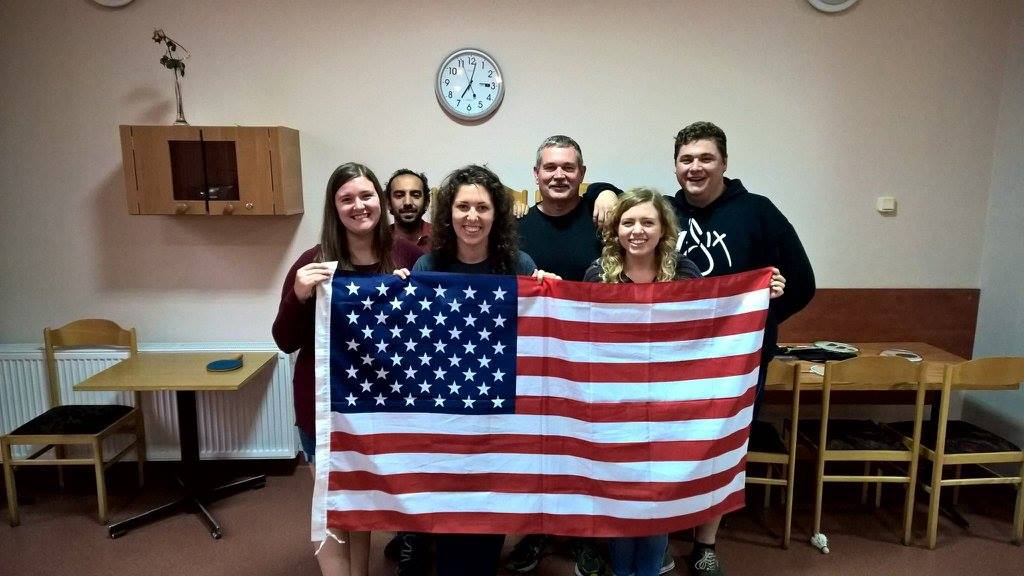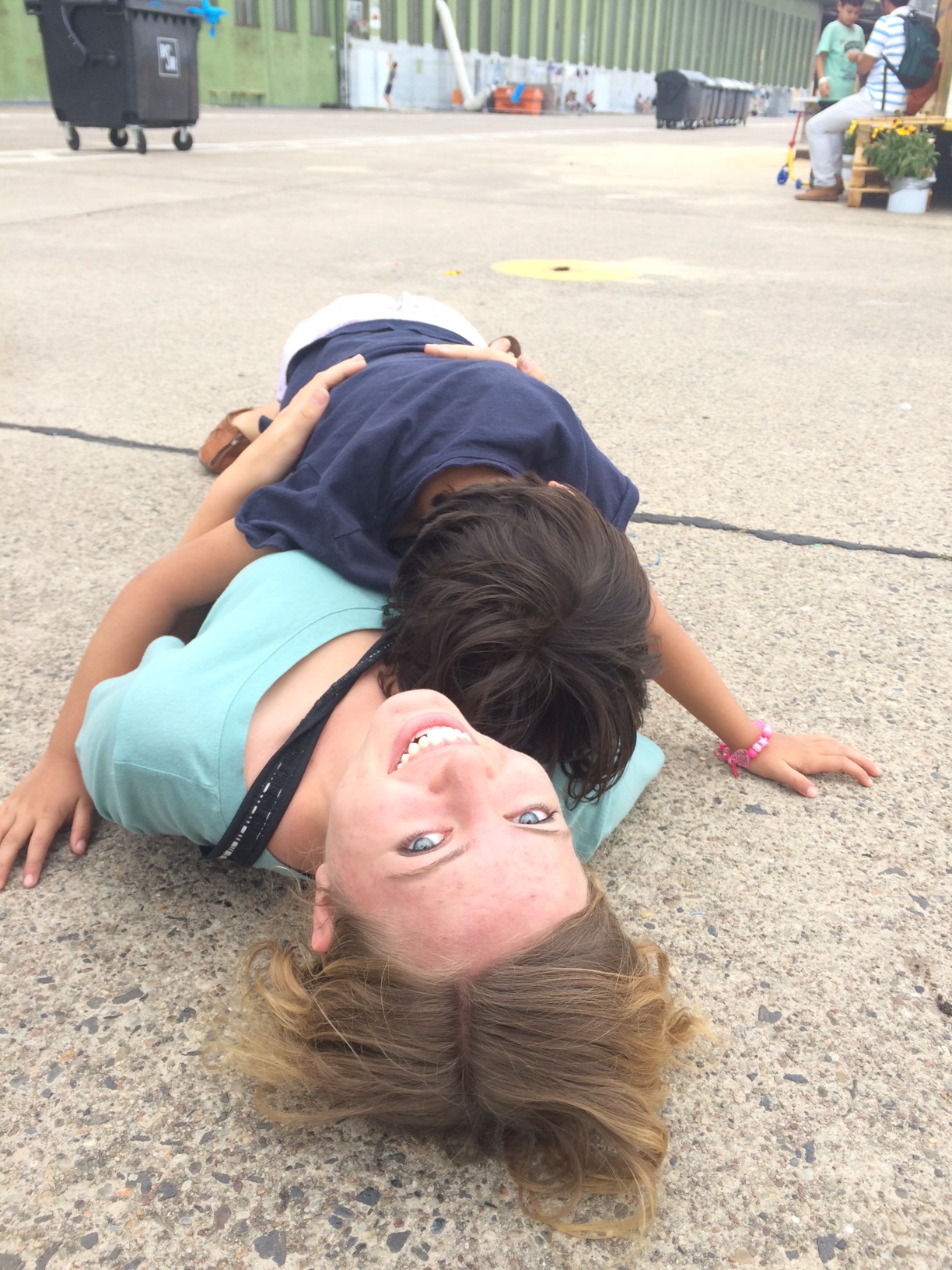Finding Refuge - One Woman's Experience With Syrian Refugees
An abandoned airport outside the city. A plastic containment dome in the woods. I walked on the women’s side of the camp. My eyes caught on each crack of light between the black curtains serving as doors for each cramped living space. A breeze blew from the cavernous terminal opening. There was room to roll two or three planes through the hangar and out onto the abandoned tarmac.
For the people there, there was no tangible hope of accelerating, lifting off the ground, or flying free. Flying home.
A flightless airport. An empty tarmac.
I saw a few children gathered at the end of the enormous hangar and playing with a guard. The children ducked and weaved and swarmed around him, making their small group look like a dozen: an optical illusion particular to young, energetic children.
The drab colors and WWII architecture revealed Tempelhof airport’s origins: it was built for the Nazis. Hitler flew in and out, filming propaganda footage as he stirred up nationalism and xenophobia. In the post-war era, Tempelhof served as an Allied base and a way for aid workers to get provisions into West Berlin, an island of Western culture inside of communist East Germany.
In its current iteration, Tempelhof is the largest migrant camp in Germany and houses over a thousand refugees from Afghanistan, Syria, Pakistan, and other Muslim majority countries.
In the summer of 2016, I led a small team of young adults on a missions trip to Berlin. We volunteered at two refugee camps: Tempelhof Airport and Moabit. Our team spent time with children and their parents who had lived anywhere from weeks to years inside the walls of these camps. My teammates, Holly, Kelly, Joseph, and Alex, smiled and laughed with even the most unruly children as we all did our best to bridge the language barrier and find common ground with the refugees.
Tempelhof was full, but it felt empty. It wasn’t far from the middle of the city, but it might as well have been a different universe.
Rewind a week previous. My team is waiting for our flight at the terminal in Miami when the news starts to break of the Munich terrorist attack.
We are scheduled to depart for Berlin in an hour. After answering calls from my pastor and missions coordinator, I squared myself with the television to watch the coverage. What world was I bringing these young adults to?

At the refugee camps, I heard so many stories that still tear into my heart; stories about young mothers, lost families, lost identities, lost minds, all filtered through an exhaustion I hadn’t ever encountered before.
The other camp, Moabit, was called “The Balloon Camp.”
To enter the plastic dome in the woods, we had to pass through an airlock that felt like a quarantine chamber. However, once inside, we encountered bright colorful children’s drawings pasted to the walls. There was a steady motion of life and unexpected energy. This camp contrasted sharply with the restlessness and tension of Tempelhof. Moabit was spilling over with smiling volunteers and excitable children.
It was here that we encountered a group of Pakistanis who had been living in Moabit for over a year. There was a man who told us he had been a music teacher in his home country. He was so excited to hear that our team was full of musicians and he pulled out his violin, imploring us to sing with him. The songs he knew in English were all Christmas songs. So there we were, in the woods of Berlin, in the middle of the summer, singing Christmas songs with a group of Christian and Muslim refugees.
Fast forward a few months after returning from our trip: the Christmas village attack, December 2016. Authorities raided the Tempelhof refugee camp just days after, looking for the perpetrators. I held my breath. They arrested a man, then let him go when they realized they had made a mistake.
As I watched the news, I remembered the sparkling eyes of the children at Tempelhof. I remembered the shy smiles and steely eyes of the men and women who walked the corridors. I remembered the kid who stole my water bottle and pedalled triumphantly away on his tricycle. That experience seemed distant.
Immigration. Refugees. Bans. Discrimination. Islam. National Security. Racism. Terrorism.
These words swirl through my news feed every day. They come through my car radio and land heavily on my heart. Political ideologies clash and result in fiery rhetoric divorced from human compassion. Have these talking heads hugged a refugee child? Have they walked the listless confines of a camp?
A few months after we returned, my team member, Joseph, released an EP with a song titled ‘Tarmac’ based on our experience at Tempelhof. He turned my view of the airport upside-down. He saw hope on the long stretch of abandoned concrete where I had seen only confinement. He saw the security of landing in God’s will. Though there is so much pain in these camps, these people have found a temporary place to land: a short refuge from the horrors in their pasts.
When I really think about it--there was hope in these camps. Not the kind of hope I see in America: the one that has you hoping in your own strength and ability to get ahead economically and socially in life. There is more pessimism and negativity buzzing around here than I care to digest. The type of hope in the camp comes from a deep knowledge that there is no turning back. You can only move forward.

Is it possible we are all on this tarmac--and only some of us realize it?
I can’t pretend to have a perfect prescription for what the U.S. government’s responsibility is to refugees. I can’t pretend I wasn’t nervous when I walked the grounds of the abandoned airport. I can’t pretend I didn’t feel like crying when the man at Moabit took out his violin. I can’t pretend I wanted the little girl’s arms around my neck to let go when it was time to leave.
Here is something I do know. An oft-repeated argument is that it is our responsibility as a nation to take care of the suffering people within our borders before focusing on the pain of other peoples and nations. Thankfully, God does not prioritize compassion. He does not cordon off His love and distribute it to those within man-made boundaries. I think of the long curtained hallways of Tempelhof and imagine the love of Christ crashing through the small cell-like partitions.
I don’t have the answer. The only thing I’m asking you to consider is to imagine faces and people and tears and laughter and violins and water bottles when you hear the word “refugees.” Collect stories of people in your heart. Imagine my voice telling you their words and how their voices sounded telling me. Imagine yourself in their shoes. Imagine Christ in their shoes. Imagine Christ in your shoes.
What would He do?
Jesus, the refugee from the Middle East, a man who was grounded on a long flightless tarmac for 33 years, spoke the words I need to hear in my heart:
For I was hungry and you gave me something to eat, I was thirsty and you gave me something to drink, I was a stranger and you invited me in, 36 I needed clothes and you clothed me, I was sick and you looked after me, I was in prison and you came to visit me.’
Then the righteous will answer him, ‘Lord, when did we see you hungry and feed you, or thirsty and give you something to drink?38 When did we see you a stranger and invite you in, or needing clothes and clothe you?39 When did we see you sick or in prison and go to visit you?’
The King will reply, ‘Truly I tell you, whatever you did for one of the least of these brothers and sisters of mine, you did for me.’
This world is not our home, so let us see beyond religions, skin color, demographics and politics to the heart of the matter: every soul is worth saving. Jesus died as much for you and I as He did each one of those refugees. For the few years we're here on this earth, we are called to be His ambassadors, His hands and feet, with an unconditional kind of love that only He can give.
// feature image by Joshua Ness. Other photos courtesy of Nicole Straussman.
